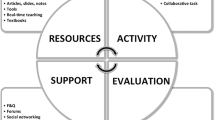Abstract
The enhanced accessibility, affordability and capability of the Internet has created enormous possibilities in terms of designing, developing and implementing innovative teaching methods in the classroom. As existing pedagogies are revamped and new ones are added, there is a need to assess the effectiveness of these approaches from the students’ perspective. For more than three decades, proven qualitative and quantitative research methods associated with learning environments research have yielded productive results for educators. This article presents the findings of a study in which Getsmart, a teacher-designed website, was blended into science and physics lessons at an Australian high school. Students’ perceptions of this environment were investigated, together with differences in the perceptions of students in junior and senior years of schooling. The article also explores the impact of teachers in such an environment. The investigation undertaken in this study also gave an indication of how effective Getsmart was as a teaching model in such environments.



Similar content being viewed by others
References
Allen, I. E., & Seaman, J. (2003). Sizing the opportunity: The quality and extent of online education in the United States, 2002 and 2003. Retrieved February 16, 2003, from http://www.sloan-c.org/resources/sizing_opportunity.pdf.
Anderson, T., Rourke, L., Garrison, D. R., & Archer, W. (2001). Assessing teaching presence in a computer conferencing context. Journal of Asynchronous Learning Networks, 5(2), 1–17. Retrieved February 16, 2003, from http://www.sloan-c.org/publications/jaln/v5n2/pdf/v5n2_anderson.pdf.
Brooks, D. W., Nolan, D. E., & Gallagher, S. M. (2001). Web-teaching (2nd ed.). New York: Kluwer/Plenum Publishers.
Chandra, V. (2004). The impact of a blended web-based learning environment on the perceptions, attitudes and performance of boys and girls in junior science and senior physics. Unpublished PhD thesis, Curtin University of Technology, Perth, Australia.
Chang, V., & Fisher, D. L. (2003). The validation and application of a new learning environment instrument for online learning in higher education. In M. S. Khine & D. L. Fisher (Eds.), Technology-rich learning environments: A future perspective (pp. 1–20). Singapore: World Scientific Publishing Co. Pte. Ltd.
Collins, A., Brown, J. S., & Newman, S. E. (1989). Cognitive apprenticeship: Teaching the craft of reading, writing and mathematics. In L. B. Resnick (Ed.), Knowing, learning and instruction: Essays in honor of Robert Glaser (pp. 453–494). Hillsdale, NJ: Erlbaum.
Committee for the Review of Teaching and Teacher Education. (2003). Australia’s teachers: Australia’s future—Advancing innovation, science, technology and mathematics. Canberra, Australia: Commonwealth of Australia. Retrieved November 25, 2008, from http://www.dest.gov.au/sectors/school_education/policy_initiatives_reviews/reviews/teaching_teacher_education/default.htm.
Cooke, S. (2005, September). Theme speaker—Implementation. Paper presented at the Association of Learning Technology Conference, Manchester, UK.
Department of Education and the Arts. (2005). Strategic Plan 2005–2009. Brisbane, Australia: Author.
Eklund, J., Kay, M., & Lynch, H. M. (2003). E-learning: Emerging issues and key trends. Retrieved November 25, 2008, from www.flexiblelearning.net.au.
Gold, S. (2001). A constructivist approach to online training for online teachers. Journal of Asynchronous Learning Networks, 5(1), 35–58. Retrieved April 27, 2003, from http://www.sloan-c.org/publications/jaln/v5n1/pdf/v5n1_gold.pdf.
Goodrum, M., Hackling, M., & Rennie, L. (2001). The status and quality of teaching and learning of science in Australian schools. Canberra, Australia: Department of Education, Training and Youth Affairs.
Janicki, T., & Liegle, J. O. (2001). Development and evaluation of a framework for creating web-based learning modules: A pedagogical and systems perspective. Retrieved November 26, 2008, from http://www.sloan-c.org/publications/jaln/v5n1/pdf/v5n1_janicki.pdf.
Jensen, E. (1998). Teaching with the brain in mind. Alexandria, VA: Association for Supervision and Curriculum Development.
Liber, O. (2005, September). Theme speaker—Architectures and infrastructures. Paper presented at the Association of Learning Technology Conference, Manchester, UK.
Mitchell, M. L., & Jolley, J. M. (2004). Research design explained. Toronto, Canada: Thomson Wadsworth.
Nunnally, J. (1967). Psychometric theory. New York: Mc-Graw Hill.
Queensland Government. (1999). Science initial in-service materials. Brisbane, Australia: Author.
Roberts, J. (2002, April 20). High school teachers ‘letting science down’. The Australian, p. C13.
Royer, R., & Royer, J. (2002). Developing understanding with multimedia. Learning & Leading with Technology, 29(7), 40–45.
The middle phase of learning. (2003, August 22). Education Views, pp. 12–13.
Tobin, K. G. (1998). Qualitative perceptions of learning environments on the world wide web. Learning Environments Research, 1, 139–162. doi:10.1023/A:1009953715583.
Wang, F.-K., & Bonk, C. J. (2001). A design framework for electronic cognitive apprenticeship. Journal of Asynchronous Learning Networks, 5(2), 131–151. Retrieved February 10, 2003, from http://www.sloan-c.org/publications/jaln/v5n2/pdf/v5n2_wang.pdf.
Wang, M. C., Haertel, G. D., & Walberg, H. J. (1993). Toward a knowledge base for school learning. Review of Educational Research, 63, 249–294.
Waxman, H. C., & Huang, S. (1998). Classroom learning environments in urban elementary, middle and high schools. Learning Environments Research, 1(1), 95–113. doi:10.1023/A:1009940816549.
Author information
Authors and Affiliations
Corresponding author
Rights and permissions
About this article
Cite this article
Chandra, V., Fisher, D.L. Students’ perceptions of a blended web-based learning environment. Learning Environ Res 12, 31–44 (2009). https://doi.org/10.1007/s10984-008-9051-6
Received:
Accepted:
Published:
Issue Date:
DOI: https://doi.org/10.1007/s10984-008-9051-6




